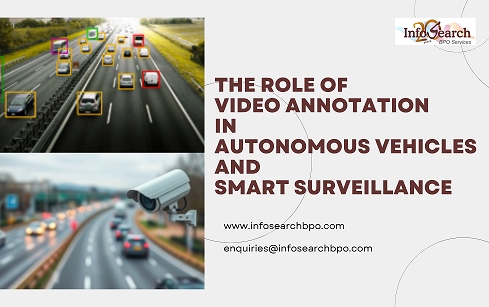Infosearch provides video annotations for various industries, including autonomous vehicles and security surveillance.
Video annotation is one of the most essential processes that make it possible to have intelligent and real-time decision-making systems due to the rapid development of computer vision. It may be used to safely guide autonomous vehicles across city streets or give surveillance platforms enough structured data to interpret the world around them, but in any case, video annotation offers these applications the rich, structured data they require to make sense of the world they inhabit.
What Is Video Annotation?
Video annotation refers to the act of identifying objects, actions or events in multiple frames of a video. In contrast to annotation of images, video annotation records time-related information- how objects shift and evolve and how they interact with one another. This is motion understanding based applications that require this time-based information.
Types of common annotations are:
- Object tracking
- Action recognition
- Event tagging
- Trajectory mapping
- Time-wasting semantic and instance segmentation.
Video Annotation in Autonomous Vehicles
The autonomous vehicles require a good video data annotated properly. As all these sensors: cameras, LiDAR, radar, and others generate a stream of visual data regularly, annotated video becomes the teacher that assists driving models to perceive and respond to the real-world situation.
- Object Detection & Tracking
The use of annotations assists models in finding:
- Vehicles
- Pedestrians
- Cyclists
- Road signs
- Construction zones
By tracing these objects within a timeframe, vehicles are able to anticipate motion by making decisions such as braking or changing lanes.
- Lane & Road Understanding
Semantic segmentation and frame by frame labelling make autonomous vehicles interpret:
- Lane markings
- Road boundaries
- Traffic signals
- Dynamic objects over the lanes.
- Behavior Prediction
Cars have to predict the manner in which adjacent items will respond. Video annotation provides temporal trends with the help of which prediction models can comprehend:
- Pedestrian intention
- Vehicle turning/ acceleration.
- Sudden obstacles
- Training Safety Critical Systems.
The situation endangers the life of human beings and therefore, autonomous vehicle systems need huge amounts of high quality annotated video to be safe and reliable. The quality of the annotation has a direct impact on on-road performance.
Video Annotation of Security Surveillance
Security Surveillance Annotation involves AI-based vision technology to track surroundings, detect threats, and react to them. Video annotation enhances this AI by providing models with the knowledge necessary to capture the human behavior and identify the anomalies.
- Activity and Behavior Recognition.
Some of the behaviors that are detected and classified with the help of annotation include:
- Loitering
- Running
- Fighting
- Patterns of suspicious movements.
This would be critical in both the protection of the retail, as well as safeguarding the critical infrastructure and airports in the context of involving the armed forces in safeguarding the population.
- Real-Time Threat Detection
Annotated data helps systems to identify:
- Unattended bags
- Intrusions
- Restricted zone violations
- Crowd abnormalities
These understandings make it possible to have automatic warnings and quicker response to an incident.
- Person & Vehicle Tracking
- Video annotation supports:
- Multi-object tracking
- Cross-network camera recognition.
Pattern detection Trajectory analysis.
This plays a significant role in traffic optimization as well as security.
- Privacy-Aware Monitoring
Privacy protection is also achieved by annotation methods as surveillance systems become more advanced, e.g. anonymizing faces, or hiding sensitive areas.
The Importance of Video Annotation
Not only object detection is needed by both autonomous vehicles and smart surveillance systems, but also temporal understanding. Video annotation provides models:
- Context across time
- Motion information
- Interaction patterns
- Simulated real-life training.
This ensures that AI is more precise, trustworthy, and able to work independently within a complicated setting.
The Emergence of AI-Helped Video Annotation
The manual methods of video labeling are labor intensive, and currently pipelines employ hybrid methods:
- AI pre-labeling in order to create preliminary annotations.
- Human correctors and refiners of labels.
This speeds up the process of creating datasets and still has high accuracy- particularly in safety critical applications.
Final Thoughts
Video annotation is also more than just a technical process it forms the foundation of intelligent real-time computer vision systems. By making self-driving vehicles comprehend their environment and surveillances identify threats before they can grow, proper annotation of videos makes sure that AI can take knowledgeable, secure, and effective decisions.
With increased interest in automation, video annotation is simply going to gain more significance, which will move transportation, and other elements of public safety, and more.
Contact Infosearch
Outsource your data annotations to Infosearch. Write to us your queries and we will get back to you within a few business hours.
https://www.infosearchbpo.com/contact.php
enquiries@infosearchbpo.com








Recent Comments